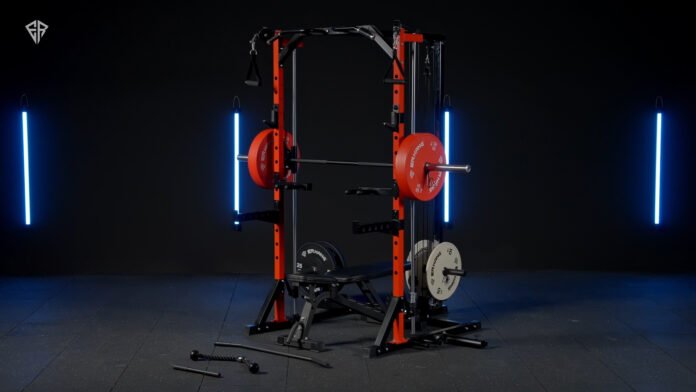If you’re serious about strength training or building a home gym, a power rack is one of the most essential pieces of equipment you can invest in. In this comprehensive guide, we’ll explore everything you need to know about MIKOLO power rack, from their benefits and types to essential accessories and tips for choosing the right one for your fitness goals.
What is a Power Rack?
A power rack, also known as a squat cage or power cage, is a large, sturdy piece of gym equipment designed to hold barbells for exercises like squats, bench presses, deadlifts, and overhead presses. The cage-like design provides multiple safety features, such as adjustable safety bars, which allow you to perform heavy lifts without a spotter.
Benefits of Using a Power Rack
- Safety First: The adjustable safety bars help prevent injuries during heavy lifts by catching the barbell if you fail mid-rep, making it safer than traditional squat stands or free weights.
- Versatile Training: With a power rack, you can perform various exercises, including squats, bench presses, pull-ups, and deadlifts, making it a multi-functional piece of equipment.
- Ideal for Home Gyms: A power rack consolidates several machines into one, maximizing space in your home gym while offering a range of strength-building exercises.
- Progressive Overload: The stability of the rack allows you to progressively increase the weight of your lifts over time, helping you to build strength and muscle safely.
Types of Power Racks
- Full Power Rack: The full power rack is the largest and most robust option, providing ample space for exercises and heavy-duty usage. It typically includes multiple attachment points for accessories like dip bars, pull-up bars, and weight storage pegs.
- Half Rack: A half rack is a more compact version of a power rack that saves space while still offering the core benefits. It has fewer attachment points but is perfect for smaller home gyms.
- Squat Stand: Squat stands are lighter and more portable but offer less stability and fewer safety features than full or half racks. They’re ideal for lifters who don’t lift ultra-heavy weights but still want a place to squat and bench press.
Key Features to Look For
- Weight Capacity: Look for a power rack that supports a weight capacity that matches your current and future strength goals. A good rule of thumb is to choose a rack that supports at least 700 lbs.
- Adjustability: Make sure the rack offers adjustable barbell positions and safety bars to accommodate your height and workout needs.
- Sturdiness and Build Quality: A rack made from heavy-duty steel with a wide base provides the stability needed for intense workouts.
- Accessories: Look for racks with additional features like pull-up bars, dip attachments, or lat pulldown attachments to maximize your workout options.
- Footprint: Measure your gym space before purchasing to ensure the rack fits comfortably, allowing room for your barbell and weight plates.
Must-Have Power Rack Accessories
- Pull-Up Bar: Most power racks come with an integrated pull-up bar, allowing you to perform pull-ups, chin-ups, and other bodyweight exercises.
- Dip Bar Attachments: Dips are great for building chest, shoulders, and triceps strength. Adding dip bars to your power rack enhances its versatility.
- J-Hooks: Adjustable J-hooks allow you to place the barbell at your preferred height, providing convenience and safety for different exercises.
- Safety Straps or Pins: These safety features catch the barbell if you miss a lift, allowing you to lift heavy without a spotter.
- Weight Storage Pegs: Integrated weight storage pegs keep your plates organized and your home gym clutter-free.
How to Use a Power Rack
- Squats: The power rack is ideal for performing squats safely. Adjust the J-hooks to just below shoulder height, place the barbell, and start your squats. The safety bars can be set to catch the barbell if you need to bail out of a lift.
- Bench Press: Set up a bench inside the rack, position the barbell at chest level, and use the safety bars as a spotter in case you can’t complete the lift.
- Deadlifts: While not all power racks come with a deadlift platform, you can still perform deadlifts by positioning the bar inside the rack. Some racks even offer attachments for specialized deadlift training.
- Pull-Ups: Use the integrated pull-up bar to train your upper body and core, or incorporate resistance bands for assistance.
Tips for Buying the Right Power Rack
- Set Your Budget: Power racks range in price depending on features and build quality. Determine how much you’re willing to invest based on your fitness goals and space.
- Consider Space: Measure your home gym to ensure the rack fits and leaves room for lifting. Full racks take up more space but offer more features, while half racks are more compact.
- Weight Capacity: Make sure the rack can handle the weight you plan to lift. If you’re an experienced lifter or plan on progressing significantly, opt for a higher weight capacity.
- Reviews and Recommendations: Check customer reviews and expert recommendations to find a rack that suits your needs and fits within your budget.
Conclusion
A power rack is an indispensable piece of equipment for any serious home gym enthusiast. It offers safety, versatility, and stability for a wide variety of strength-building exercises. Whether you’re a beginner or an experienced lifter, investing in a high-quality power rack can help you progress in your fitness journey while training safely at home. Make sure to consider your space, goals, and budget when choosing the right power rack for your home gym setup.
Read also: https://readpots.com/

